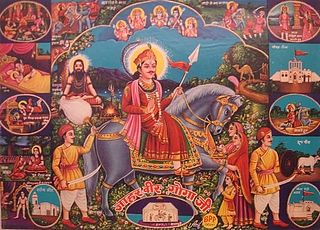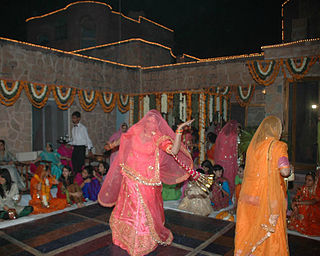External links
| This article about Indian dance is a stub. You can help Wikipedia by expanding it. |
Sapera is a form of dance from India. It is commonly thought of as a snake dance it is a dance that features heavily in the twirls with richly embroidered robes flaying out in display.
Sapera is a name given to the snake charmers of India. Since the introduction of the Wildlife Protection Act of 1972 the Sapera's numbers have been dwindling - what was in the thousands is now limited to only a few hundred. Their professions and their religion are slowly being 'phased out' by a law that was put in place to stop the illegal skin/fur trade.
Many Sapera practice their trade/snake handling based upon their following of the God Shiva - depicted with a Cobra.
Most of the saperas are found to be in Dehradun, Uttarakhand north part of India. But some saperas are also to be found in some parts of Bihar where they doing business from unstable places, moving here and there, and show their talents with 'saanp' snakes and earn some money.
| This article about Indian dance is a stub. You can help Wikipedia by expanding it. |

Snakes are elongated, legless, carnivorous reptiles of the suborder Serpentes. Like all other squamates, snakes are ectothermic, amniote vertebrates covered in overlapping scales. Many species of snakes have skulls with several more joints than their lizard ancestors, enabling them to swallow prey much larger than their heads with their highly mobile jaws. To accommodate their narrow bodies, snakes' paired organs appear one in front of the other instead of side by side, and most have only one functional lung. Some species retain a pelvic girdle with a pair of vestigial claws on either side of the cloaca. Lizards have evolved elongate bodies without limbs or with greatly reduced limbs about twenty-five times independently via convergent evolution, leading to many lineages of legless lizards. Legless lizards resemble snakes, but several common groups of legless lizards have eyelids and external ears, which snakes lack, although this rule is not universal.

The Malayali people are a Dravidian ethnic group originating from the present-day state of Kerala in India, occupying its southwestern Malabar coast. They are identified as native speakers of the Malayalam language. The state of Kerala was created in 1956 through the States Reorganisation Act. Prior to that, since the Middle Ages existed the Kingdom of Cochin, the Kingdom of Travancore and the Malabar District of the Madras Presidency. The Malabar District was annexed by the British through the Third Mysore War (1790–92) from Tipu Sultan. Before that, the Malabar District was under the Zamorins of Calicut since the Middle Ages.

Naga Panchami is a day of traditional worship of Nagas or snakes observed by Hindus throughout India, Nepal, and other countries where Hindu adherents live. The worship is offered on the fifth day of bright half of lunar month of Shravana (July/August), according to the Hindu calendar. Some Indian states, such as Rajasthan and Gujarat, celebrate Naga Panchami on the dark half of the same month. As part of the festivities, a Naga or serpent deity made of silver, stone, wood, or a painting of snakes is given a reverential bath with milk and their blessings are sought for the welfare of the family. Live snakes, especially cobras, are also worshipped on this day, especially with offerings of milk and generally with the assistance of a snake charmer.

Snake charming is the practice of appearing to hypnotize a snake by playing and waving around an instrument called a pungi. A typical performance may also include handling the snakes or performing other seemingly dangerous acts, as well as other street performance staples, like juggling and sleight of hand. The practice was historically the profession of some tribesmen in India but this is no longer the case. Snakecharmer performances still happen in other Asian nations such as Pakistan. Bangladesh, Sri Lanka and south-east Asian nations like Thailand, and Malaysia are also home to performers, as are the North African countries of Egypt, Morocco and Tunisia.

Gogaji is a folk deity, worshipped in the northern states of India especially in Rajasthan, Himachal Pradesh, Haryana, Uttarakhand, Punjab region, Uttar Pradesh, Jammu and Gujarat. He is a warrior-hero of the region, venerated as a saint and a 'snake-god'.

Ptyas mucosa, commonly known as the oriental ratsnake, Indian rat snake, 'darash' or dhaman, is a common species of colubrid snake found in parts of South and Southeast Asia. Dhamans are large snakes. Typical mature total length is around 1.5 to 1.95 m though specimens exceeding 2 m are not uncommon. The record length for this species was recorded as 3.7 m, second in size perhaps only to their cousin Ptyas carinata among all known living colubrid snakes. Despite their large size, oriental ratsnakes are usually quite slender with even a specimen of 2 m commonly measuring 4 to 6 cm only around in diameter. Furthermore, the average weight of ratsnakes caught in Java was around 877 to 940 g, though larger males of over 2.3 m may easily weigh over 2.5 kg (5.5 lb). Their colour varies from pale browns in dry regions to nearly black in moist forest areas. Dhamans are diurnal, semi-arboreal, non-venomous, and fast-moving. Dhamans eat a variety of prey and are frequently found in urban areas where rodents thrive.

Ghoomar is a traditional folk dance of Rajasthan. It was Bhil tribe who performed it to worship Goddess Sarasvati which was later embraced by other Rajasthani communities. The dance is chiefly performed by veiled women who wear flowing dresses called ghaghara. It was ranked 4th in the list of "Top 10 local dances around the world" in 2013. The dance typically involves performers pirouetting while moving in and out of a wide circle. The word ghoomna describes the twirling movement of the dancers and is the basis of the word ghoomar.

Snakes, like other reptiles, have skin covered in scales. Snakes are entirely covered with scales or scutes of various shapes and sizes, known as snakeskin as a whole. A scale protects the body of the snake, aids it in locomotion, allows moisture to be retained within, alters the surface characteristics such as roughness to aid in camouflage, and in some cases even aids in prey capture. The simple or complex colouration patterns are a property of the underlying skin, but the folded nature of scaled skin allows bright skin to be concealed between scales then revealed in order to startle predators.
Kalbelia or Kabeliya is a dance from Rajasthan, performed by the tribe of the same name. The dance is an integral part of their culture and performed by men and women.

Nagin is a 1976 Hindi-language horror film, produced and directed by Rajkumar Kohli under the Shankar Movies banner. It features a huge ensemble cast including Sunil Dutt, Feroz Khan, Jeetendra, Sanjay Khan, Rekha, Mumtaz, Reena Roy, Vinod Mehra, Yogeeta Bali, Kabir Bedi, Anil Dhawan in the lead roles and music composed by Laxmikant Pyarelal. The film was a Blockbuster at the box office. Following the success of the film, the lead actress Reena Roy received widespread attention and popularity. # 3 At Box-Office collection list.

This is a list of dances of the Romani people.

Debaki Bose (1898–1971), Padma Shri, also known as Debaki Kumar Bose, was an Indian director, writer, and actor who is recognized for his contribution in Hindi as well as Bengali cinema. He was born on 25 November 1898 in Akalposh,, Burdwan, Bengal, British India. He died on 17 November 1971 in Calcutta, West Bengal, India. He is known for his innovative use of sound and music in Indian Cinema. He worked first under the banner of British Dominion Films of Dhiren Ganguly and later with Pramathesh Barua's Barua Pictures and finally he joined New Theatres banner in 1932. He started his own production company, Debaki Productions, in 1945.

Thierry Robin known as Titi Robin, is a French composer and improviser. His style combines Mediterranean world including Gypsy, Oriental and European cultures. He plays guitar, buzuq, mandolin and ’oud.
Kumkum, born Zaibunnisa, was an Indian film actress from Hussainabad in Sheikhpura district, Bihar. Her father was Nabab of Hussainabad and belonged to a highly regarded family. She acted in approximately 115 films during her career. She is best known for her roles in Mr. X in Bombay (1964), Mother India (1957), Son of India (1962), Kohinoor (1960), Ujala, Naya Daur, Shreeman Funtoosh, Ek Sapera Ek Lutera, Ganga Ki Laharen, Raja Aur Runk, Aankhen (1968), Lalkaar, Geet and Ek Kuwara Ek Kuwari. She paired with many film heroes of her era and was popular in roles alongside Kishore Kumar.

The Sapera are a Hindu caste found in North India. They are also known as Barwa Sampheriya in West Bengal, Sapela in Punjab and Sparera in Madhya Pradesh.

The Sapera are a Muslim community found in the state of Bihar in India. They are also known as Mastan and Ustad.
The Sapuria are a Muslim community found in the state of West Bengal in India, as well as in Bangladesh. They are also known as Bedia Mal and Sanpui.

Gulabo Sapera is a dancer from Rajasthan, India.
Sapera is a form of dance from India practised by the Romani peoples.
Wildlife SOS (WSOS) is a conservation non-profit in India, established in 1995 with the primary objective of rescuing and rehabilitating wildlife in distress, and preserving India’s natural heritage. It is currently one of the largest Wildlife Organisations in South Asia.